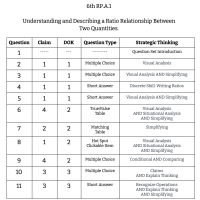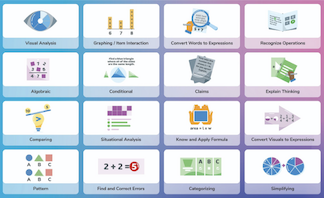
6th Grade Math - RP.A.1 - Understanding and Describing a Ratio Relationship Between Two Quantities
11 Questions
Understanding and Describing a Ratio Relationship Between Two Quantities Introduction
Part A: The chart below indicates how many animals are currently being housed at the local animal shelter. Use its data to answer the question below.
Part B: The chart below indicates how many animals are currently being housed at the local animal shelter. Use its data to answer the question below.
Dominic spills some M & Ms out of the bag. He notices that there are 7 red, 9 brown, and 3 yellow ones. Type in the ratio for yellow to brown in ALL THREE forms.
It is near the end of the day at the local farmer's market and one vendor is nearly out of fruit. All he has left is listed in the table below.
Which statements are true about the graph below?
Identify the ratio in each problem. Match the ratio to its simplified form.
Analyze each box of images below. Click on the TWO boxes that contain a 1:3 ratio.
Which ratio meets the criteria listed below?
Eloise is asked to split the number 48 into two groups so that the ratio between the two groups is 1:3. She argues that it cannot be done. Do you agree? Explain.
Last week, Ben ate 3 chocolate chip cookies, 7 sugar cookies, 6 peanut butter cookies, and 4 oatmeal cookies.

We help districts in California boost CAASPP Math Scores by Δ +20% by helping teachers determine if students are struggling with the content, the technology involved with the type of question, or the type of strategic thinking required. Based on the 8 Standards for Mathematical Practice, our platform and professional development empowers teachers to recognize all 16 types of strategic thinking across any math question, curriculum, or assessment.
Learn more